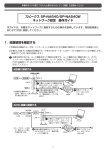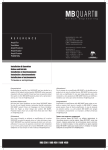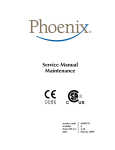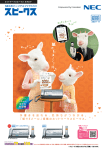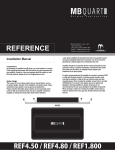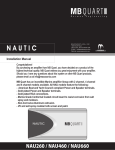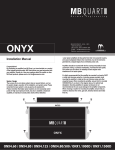Download MB QUART NA180.2 Installation manual
Transcript
NAUTIC Installation Manual Congratulations! By purchasing an amplifier from MB Quart, you have decided on a product of the highest technical quality. MB Quart wishes you great enjoyment with your amplifier. Should you have any questions about this system or other MB Quart products, please email us at [email protected] MB Quart has an incredible Marine amplifier lineup with 2, 4, 5 and 6 channel models available. All NA models feature the following: - American Boat and Yacht Council compliant Power and Speaker terminals. - Gold plated Power and Speaker terminals. - Marine Grade Conformal Coated circuit board to resist corrosion from salt spray and moisture. - Non-Corrosive Aluminum extrusion. - UV and salt spray resistant silk screen and paint. NA180.2 / NA360.4 / NA710.5 / NA540.6 INSTALLATION INSTRUCTIONS General Instructions General: Run the wiring so that RCA cables are at least 18“ away from power and speaker cables. Keep RCA cables away from electrical devices in the vehicle that can cause electrical noise, such as electric fuel pumps, emission control modules and other on-board electronic modules. Power and ground connections:(See table below) Use a sufficient gauge power cable and ground cable using the chart below as reference to what size wire you require. NAUTIC series amplifiers require at least 4 gauge power wire. In a multi amplifier system, add the total value of the manufacture recommended fusing to get your total system amperage. Some applications may require multiple runs of power wire to meet the system requirements. In multi amplifier systems it is advisable to mount a large enough fuse right at the battery, and run one or multiple +12 volt power cables to a fused distribution block near the amplifiers. It is then a simple matter to connect the +12 volt terminal of each amplifier to the distribution block. During this process, please ensure that the main power fuse is removed to avoid shorting the electrical system. The main fuse must be within 12” of the vehicles battery. Ground each amplifier with as short a ground lead as possible directly to the vehicle chassis using at least 4 gauge wire or equivalent to the size of the amplifiers’ power wire. Use a ground distribution block, if you wish, but it is extremely important to keep the main ground lead from this distribution block to the chassis as short as possible , not more than 12“. The ground connection integrity to the chassis is very important, and the best way to achieve a good, solid electrical and mechanical contact is to use a large round crimp lug, crimped and soldered to the ground cable. The next step is to scrape the paint off the vehicle chassis , slightly larger than the ground lug, at the connection point. Drill a clearance hole in the chassis, the same size as the lug hole, and use a bolt, spring washer and nut to securely fasten the ground lug. Use petroleum jelly to coat the bolt/lug connection, to prevent oxidization with time. TIP: Use the same approach when installing head units, equalizers or any audio equipment for that matter - run short individual grounds from each piece directly to the vehicle chassis, to minimize ground loops and system noise. All power, ground and speaker connections should be crimped and soldered for reliability. Make sure that none of the cable insulation can chafe against exposed metal in the vehicle, causing short circuits to the chassis. Safe connection sequence: After all cables are run, connect speaker wires to the speakers and amplifiers, then run and plug in RCA cables. Next, connect all power, ground, and remote turn on leads. Now connect all +12 volt cables to the amplifier/s and distribution blocks and fuse holders. Finally, connect the main +12 volt cable to the battery, with the main fuse removed, and we are almost ready to power up the system. Power up the system: The following procedure may seem like overkill, but there is nothing more frustrating when turning on a system for the first time, and it does not work properly immediately. First, make sure the head unit is off, and turn all level controls to minimum (counterclockwise), including the head unit volume control. Set all equalizers to 0 dB (no boost), and all crossover frequency controls at approximate frequencies, as recommended by the loudspeaker manufacturer. Set all input selector and crossover switches as required for the application. Remove all amplifier fuses, and insert the main fuse at the battery. If the fuse does not blow, you can insert the fuse in one of the amplifiers, and we are ready to turn on the system. Turn the head unit on, insert a CD, or select a radio station, and increase the head unit volume control. If the system sounds fine, turn off the head unit, and install fuses in the remaining amplifiers, one by one, till the complete system is powered up and functioning properly. WIRE LENGTH SYSTEM AMPERAGE 10-13 ft. 13-16 ft. 16-19 ft. 19-22 ft. 22-28 ft. 35-50 8 6 4 4 4 4 50-65 6 4 4 4 4 2 68-85 4 4 2 2 2 0 85-105 4 2 2 2 2 0 105-125 4 2 0 0 0 0 125-150 2 0 0 0 0 0 WIRE GAUGE 7-10 ft. INSTALLATION INSTRUCTIONS Settings for Best Performance NA180.2 / NA360.4 / NA710.5 / NA540.6 General: At this point you are ready to get more specific on the settings for your amplifier. Filter Adjustments (Crossover) High: -When in High Pass operation, this setting acts as a low frequency cut off for your system reproduction. The point that you set it at cuts off any frequencies from reproduction beyond this point. The 12 o’clock position is a great starting point. EXAMPLE: If you adjust the Frequency to 100Hz, the amplifier will not play frequencies below 100Hz but will play frequencies from 100Hz to the highest frequency the amplifier is capable of reproducing. Low: The Low Pass adjustment acts as a ceiling and doesn’t allow frequencies to the right of the desired setting to be reproduced. Turning the Frequency all the way to the right is a great starting point. EXAMPLE: If you adjust the Frequency to 120Hz, the amplifier will not play frequencies above 120Hz but will play frequencies from 120Hz to the lowest frequency your amplifier can reproduce. Flat: The Flat adjustment bypasses the crossover and allows all frequencies to be sent from the amplifier to your speakers and subwoofers. Bass EQ: This setting is a fixed bass boost at 45Hz that is variable. NA710.5 is 0-10dB on the 5th channel while the NA180.2/NA360.4/NA540.6 are 0-9dB. This feature provides impact to your bass, but if not adjusted correctly, it can be over used and cause damage to your speakers and amplifiers. It is best to slowly turn this setting clockwise until the desired punch is felt. It is not recommended to exceed the 12 o’clock position unless listening at a low volume or a low recording quality as this can result in high distortion and possibly clipping. Level Control Setup: Ensure that the Level is turned completely to the left prior to turning the system on. Next you should insert a CD or cassette that you are familiar with to use as a reference, and turn the head unit volume control to about 80% of its full setting. The system sound level will of course be very low, and the following procedures will help you to match the amplifier input sensitivities properly to the head unit output signal level. It is important to match the amplifier LEVEL input sensitivity to the Radio/CD output sensitivity. This can be located in the Radio/CD manual. If the Radio/CD output sensitivity is 2 volts, then adjust the amplifier LEVEL input to 2 volts. If you are not sure what the Radio output sensitivity is, follow these general guide lines: Turn the level control up slowly, till you hear distortion, then back off a few degrees on the control. If at any point your amplifier goes into protection, you will need to turn the Level to the left a bit and then try again. If you reach a point where the output does not increase, stop turning the Level control to the right as the amplifier/speaker combo has reached its maxx output in this application. TROUBLE SHOOTING The key to finding the problem in a misbehaving sound system is to isolate parts of that system in a logical fashion to track down the fault. Description of the Diagnostic system built into all MB Quart amplifiers The diagnostic system will shut down the amplifier, until reset by turning the head unit off, and back on. This state of affairs will be indicated by the front panel PROTECT LED lighting up under the following conditions: 1 - A short circuit on the loudspeaker leads. 2 - An internal amplifier fault that causes a DC offset on the loudspeaker output. Should the amplifier go into diagnostic mode, simply disconnect all RCA and speaker leads, while keeping +12 volt, power ground and remote leads connected. 1. Now turn the amplifier back on, and if the diagnostic LED lights, the amplifier has an internal fault. 2. If not, plug the RCA cables back, and reset the amplifier. If it goes into diagnostic now, the fault lies in the input, either with bad cables or source unit. 3. If the amplifier seems fine with RCA cables plugged in, connect the speakers, one at a time, and if one of the speakers or its wiring is faulty, it will activate the diagnostic system. Amplifier heatsink overheating The amplifiers will shut down when the heatsink temperature reaches 80 degrees centigrade, and turn back on once the unit has cooled down below that point. Causes of overheating: 1 - Inadequate cooling - relocate or remount to provide better natural airflow over the fins. 2 - Driving high power levels into low impedances - back off on the volume control, and/or make sure you are not loading the amplifier with less than the recommended loudspeaker impedance. Low output power 1 - Check that level controls have been set up properly. 2 - Make sure that the battery voltage, as measured at the amplifier’s +12 volt and ground terminals, is 11 volts or more. 3 - Check all +12 volt and ground connections. Fuses blowing 1 - The use of loudspeaker impedances below the recommended minimums will draw more current - check. 2 - A short on the main +12 volt cable from the battery to ground will cause the main fuse to blow. System does not turn on 1 - Check all fuses. 2 - Check all connections. 3 - Measure the +12 volt and remote turn on voltages at the amplifier terminals. If these are non existent or low, take voltage measurements at fuse holders, distribution blocks, the head unit’s +12 volt and remote leads to localize the problem. Noise problems System noise can be divided into two categories, hiss, and electrical interference. Hiss, or white noise 1 - High levels of white noise usually occurs when amplifier level controls are turned up too high - readjust according to the procedures in section ”Setting up systems after installation for best performance” 2 - Another major problem that can cause excessive hiss, is a noisy head unit - unplug the amplifier input RCA cables, and if the hiss level reduces, the source unit is at fault. Electrical interference The inside of an boat is a very hostile electrical environment. The multitude of electrical systems, such as the ignition system, alternator, fuel pumps, air conditioners, to mention just a few, create radiated electrical fields, as well as noise on the +12 volt supply and ground. Remember to isolate the problem - first unplug amplifier input RCA cables, if the noise is still present, check the speaker leads, if not, plug the RCA’s back, and investigate the source driving the amplifier, one component at a time. A ticking or whine that changes with engine RPM: 1 - This problem could be caused by radiation pickup of RCA cables too near to a fuel pump or a distributor, for instance, - relocate cables. 2 - Check that the head unit ground is connected to a solid ground. 3 - Try to supply the head unit with a clean +12 volt supply directly from the battery +, instead of using a supply from the in dash wiring/fusebox. A constant whine: This type of noise can be more difficult to pinpoint, but is usually caused by some kind of instability, causing oscillations in the system. 1 - Check all connections, especially for good grounds. 2 - Make sure that no speaker leads are shorting. 3 -RCA cables are notorious for their problematic nature, so check that these are good, in particular the shield connections. NA180.2 LINE INPUT LINE OUTPUT 2-Channel Amplifier BASS EQ CH-1 FREQUENCY LEVEL FILTER PROTECTION CH-1 POWER 0dB 9dB 40Hz 250Hz LOW FLAT HIGH 6V CH-2 CH-2 FEATURES: - 1 Set of RCA inputs - LEVEL: Variable sensitivity from 0.2V to 6V - BASS EQ: Adjustable 45Hz bass boost from 0dB to 9dB - X-OVER: Selects internal crossover functions - FLAT: Bypasses all crossovers for full frequency operation - LOW: Selects the built in LOW PASS filter - HIGH: Selects the built in HIGH PASS filter 0.2V - POWER LED: Indicates the powered up and turned on condition - PROTECTION LED: Indicates a high voltage, low voltage, short circuit, hard clip, over heating or DC fault condition. - LINE OUTPUT: Full range RCA pass through. 2 Channel Full Range Stereo: Interconnect cable checklist: - Connect the two inputs of the amplifier to a Radio/CD with quality RCA cables. Switch setting checklist: - 1/2CH X-OVER: FLAT Control checklist: - Refer to the section “Settings for Best Performance” Minimum final loudspeaker impedances: PROTECTION POWER SPEAKER OUTPUT BRIDGED + CH-1 + CH-2 - LINE OUTPUT CH-1 CH-2 9dB BASS EQ 0dB FUSE 250Hz FREQUENCY 40Hz LOW POWER INPUT LEVEL GND 6V 0.2V REM BATT+12V FILTER FLAT HIGH LINE INPUT CH-1 CH-2 Bridged for Subwoofer Application: Here we show how to use the 2 channel amplifiers to power a subwoofer by taking advantage of the mono bridging capability of all MB Quart amplifiers. Interconnect cable checklist: - A MONO signal source is suggested to bridge channels 1/2, such as would be available from the mono sub bass output of an active crossover, whether standalone, or built into a head unit or equalizer. If you only have 1 set of RCA outputs from your headunit, you can simply connect those to the inputs for CH1-2 and the amplifier will auto sum the signal and provide mono output. Important: Do not be tempted to connect the hot, or positive outputs, from any source together to obtain a mono signal, as this could very well damage the output stage of that source. - Connect the mono speaker positive terminal to the CH1 +, and its negative terminal to CH2 as shown. Switch setting checklist: - X-OVER: LOW Control checklist: - Refer to the section “Settings for Best Performance” Minimum final loudspeaker impedances: - 2 ohm per channel in stereo mode. - 4 ohm mono bridged. PROTECTION 9dB BASS EQ 0dB 250Hz FREQUENCY 40Hz FUSE POWER SPEAKER OUTPUT BRIDGED + CH-1 + CH-2 - LINE OUTPUT CH-1 CH-2 POWER INPUT 6V LEVEL 0.2V GND FILTER FLAT HIGH REM BATT+12V LOW MONO LINE INPUT (Unless using procedure described above) LINE INPUT CH-1 CH-2 NA360.4 LINE OUTPUT 4-Channel Amplifiers LINE INPUT CH-1 CHANNEL 1 & 2 PROTECT CH-1 POWER 0dB 9dB BASS EQ 40Hz 250Hz FREQUENCY LOW FLAT HIGH FILTER 6V 0.2V LEVEL CH-3 CH-4 MODE CH-2 2CH FEATURES: - 2 Sets of RCA inputs - LEVEL: Variable sensitivity from 0.2V to 6V - X-OVER: Selects internal crossover functions - FLAT: Bypasses all crossovers for full frequency operation - LOW: Selects the built in LOW PASS filter - HIGH: Selects the built in HIGH PASS filter 4CH 0dB 9dB 40Hz 250Hz LOW FLAT HIGH 6V 0.2V CHANNEL 3 & 4 CH-2 - BASS EQ: Adjustable 45Hz bass boost from 0dB to 9dB - POWER LED: Indicates the powered up and turned on condition - PROTECTION LED: Indicates a high voltage, low voltage, short circuit, hard clip, over heating or DC fault condition. - MODE: “2” indicates one set of RCA’s are being used. This will also pass signal to channels 3/4 through 1/2 inputs. “4” indicates connecting 2 sets of RCA’s to 1/2 and 3/4 inputs. - LINE OUTPUT: Full range RCA pass through. 4 Channel Full Range Stereo: Interconnect cable checklist: - Connect the four inputs of the amplifier to a Radio/CD with quality RCA cables. Switch setting checklist: - 1/2CH X-OVER: FLAT - 3/4CH X-OVER: FLAT MODE: “4” since 2 sets of RCA’s are connected. 0dB 9dB BASS EQ 0dB + CH-3 + CH-4 BRIDGED BRIDGED + CH-1 + CH-2 - PROTECT POWER 4CH MODE 2CH 9dB FUSE CHANNEL 1 & 2 6V 6V 0.2V CHANNEL 3 & 4 0.2V LEVEL LINE INPUT CH-1 CH-2 CH-3 CH-4 Important: Do not be tempted to connect the hot, or positive outputs, from any source together to obtain a mono signal, as this could very well damage the output stage of that source. - It is necessary to feed the SAME signal to both left and right inputs via a Y-adapter RCA cable. - Connect the mono speaker positive terminal to the CH3 +, and its negative terminal to CH4 as shown. Switch setting checklist: - 1/2CH X-OVER: FLAT - 3/4CH X-OVER: LOW Control checklist: - Refer to the section “Settings for Best Performance” Minimum final loudspeaker impedances: - 2 ohm per channel in stereo mode. - 4 ohm mono bridged. LINE OUTPUT CH-1 PROTECT POWER 0dB 0dB 9dB BASS EQ 9dB 6V 0.2V LEVEL FUSE 6V 0.2V CHANNEL 3 & 4 CHANNEL 1 & 2 FLAT HIGH LOW FLAT HIGH FILTER LOW REM BATT+12V 250Hz LINE INPUT CH-1 CH-2 POWER INPUT 40Hz 40Hz 250Hz FREQUENCY GND 4CH MODE 2CH BRIDGED + CH-1 + CH-2 - CH-2 + CH-3 + CH-4 BRIDGED FLAT HIGH POWER INPUT LOW FLAT HIGH FILTER LOW REM BATT+12V 250Hz GND 40Hz 40Hz 250Hz FREQUENCY Here we show how to use the 4 channel amplifiers as a 3 channel unit by taking advantage of the mono bridging capability of all MB Quart amplifiers. In order to create a 2 channel system, simply follow the example to also mono bridge channel pair 1/2. Interconnect cable checklist: - Connect the inputs of channel pair 1/2 to a suitable stereo source, e.g. a head unit with good quality RCA cables. - A MONO signal source is suggested to bridge channel pair 3/4, such as would be available from the mono sub bass output of an active crossover, whether standalone, or built into a head unit or equalizer. If you only have 1 set of RCA outputs from your headunit, you can simply connect those to the inputs for ch 1/2 and switch the MODE to 2. The amplifier will auto sum the signal and provide mono output for bridged channels 3/4. CH-3 CH-4 MONO LINE INPUT (Unless using procedure listed above for 2ch) Minimum final loudspeaker impedances: - 2 ohm per channel. LINE OUTPUT CH-1 CH-2 2 or 3 Channel System: STEREO LINE INPUT Control checklist: - Refer to the section “Settings for Best Performance” NA710.5 X-OVER Ch1 / Ch2 Ch2 Ch4 5-Channel Amplifiers Ch5 LEVEL HI PASS 50Hz Ch3 INPUT 6V 4Khz Interconnect cable checklist: Connect channel 1&2 inputs to the front output, channels 3&4 to the rear output, and channel 5 to the mono subwoofer output of a head unit or in dash equalizer. Switch setting checklist: - CH 1 / 2 X-OVER: FULL - CH 3 / 4 X-OVER: FULL REMOTE 30Hz 150hz LOW PASS 6V 0dB 10dB BASS BOOST 0.2V LEVEL MODE: “5” since 3 sets of RCA’s are connected. Control checklist: - Refer to the section “Settings for Best Performance” Minimum final loudspeaker impedances: - 2 Ohms per channel for channels 1-4 - 2 Ohms on channel 5 Ch3 Ch4 5CH - Ch1 Ch2 Ch5 BRIDGED + 4CH - + INPUT 3CH + + X-OVER Ch3 / Ch4 HP FULL BP POWER PROTECT Ch5 4kHz LOW PASS 6V 0.2V LEVEL MODE 250Hz Ch2 Ch4 Ch5 POWER INPUT 0.2V LEVEL HI PASS 6V 50Hz 150hz 1CH 0.2V LEVEL BRIDGED + 2CH - HI PASS 6V 0dB 10dB BASS BOOST REM BATT+12V LLUF IH FULL 4Khz 30Hz 150hz LOW PASS 50Hz GND HP X-OVER Ch1 / Ch2 REMOTE Interconnect cable checklist: Connect Stereo Left and Right RCA’s from headunit to CH1&2 RCA Inputs. MODE: “2” since 1 set of RCA’s are connected. Control checklist: - Refer to the section “Settings for Best Performance” Minimum final loudspeaker impedances: - 2 Ohms per channel for channels 1-4 - 1 Ohm on channel 5 Switch setting checklist: - CH 1 / 2 X-OVER: FULL - CH 3 / 4 X-OVER: FULL Ch3 Ch4 5CH - Ch1 Ch2 Ch5 BRIDGED + 4CH - + INPUT 3CH + + X-OVER Ch3 / Ch4 HP FULL BP POWER PROTECT Ch5 4kHz LOW PASS 6V 0.2V LEVEL MODE 250Hz Ch2 Ch4 Ch5 POWER INPUT 0.2V LEVEL HI PASS 6V 50Hz 150hz 1CH 0.2V LEVEL BRIDGED + 2CH - HI PASS 6V 0dB 10dB BASS BOOST REM BATT+12V FULL 4Khz 30Hz 150hz LOW PASS 50Hz GND HP X-OVER Ch1 / Ch2 REMOTE LLUF IH LEVEL PROTECT 4kHz 6V 0.2V Ch5 Ch2 Ch4 Ch5 MODE - POWER LED: Indicates the powered up and turned on condition - PROTECTION LED: Indicates a high voltage, low voltage, short circuit, hard clip, over heating or DC fault condition. - MODE: “2” indicates one set of RCA’s are being used. This will also pass signal to channels 3/4 and 5 through 1/2 inputs. “4” indicates connecting 2 sets of RCA’s to 1/2 and 3/4 inputs. “5” indicates connecting 3 sets of RCA’s to channels 1/2, 3/4 and mono signal to channel 5 inputs. Single Set of Stereo RCA’s We will use the same basic setup on the speaker and subwoofer connections as above to illustrate an installation that only has 1 set of stereo RCA’s to connect to this amplifier. By switching the amplifier to 2CH on the INPUT MODE, you now provide signal to all channels on the amplifier. You sacrifice the ability to fade front to rear though. LOW PASS 250Hz 50Hz 150hz 0.2V 5 Channel Discrete Operation: You can use this configuration simply as 4 discrete full range channels, with a 5th low pass channel. All of the crossovers are bypassed , except the LOW PASS on channel 5. X-OVER Ch3 / Ch4 HP FULL BP POWER Ch1 FEATURES: - 3 Sets of RCA inputs - LEVEL: Variable sensitivity from 0.2V to 6V - BASS BOOST: Adjustable 45Hz bass boost from 0dB to 10dB - X-OVER: Selects internal crossover functions - FULL: Bypasses all crossovers for full frequency operation - BP: Selects the built in LOW PASS filter - HP: Selects the built in HI PASS filter HI PASS HI FULL HP FULL NA540.6 CH-6 CH-4 LINE OUTPUT DIAGNOSTICS CH-2 CHANNELS 1 & 2 MODE PROTECT 6-Channel Amplifiers CH-2 LOW FLAT HIGH 6V 40Hz .2V LEVEL FILTER 250Hz 0dB POWER 9dB FREQUENCY BASS EQ 6-CH 4-CH 2-CH LEVEL FILTER FREQUENCY BASS EQ CHANNELS 5 & 6 CHANNELS 3 & 4 CH-1 CH-5 CH-3 LINE INPUT FEATURES: - 3 Sets of RCA inputs - LEVEL: Variable sensitivity from 0.2V to 6V - BASS BOOST: Adjustable 45Hz bass boost from 0dB to 9dB - X-OVER: Selects internal crossover functions - FLAT: Bypasses all crossovers for full frequency operation - LOW: Selects the built in LOW PASS filter - HIGH: Selects the built in HI PASS filter CH-1 6V LOW FLAT HIGH .2V LOW FLAT HIGH 40Hz 250Hz 0dB 9dB 6V 40Hz .2V 250Hz 0dB 9dB - POWER LED: Indicates the powered up and turned on condition - PROTECTION LED: Indicates a high voltage, low voltage, short circuit, hard clip, over heating or DC fault condition. - MODE: “2” indicates one set of RCA’s are being used. This will also pass signal to channels 3/4 and 5/6 through 1/2 inputs. “4” indicates connecting 2 sets of RCA’s to 1/2 and 3/4 inputs. “6” indicates connecting 3 sets of RCA’s to channels 1/2, 3/4 and 5/6. 6 Channel Full Range Stereo 3. Crossover frequency control checklist: N/A for full range operation. 4. Line Level: Refer to section “Setting up systems after installation for best performance.” + CH-4 CH-3 6V .2V + 4CH CHANNELS 1 & 2 LOW FLAT HIGH FILTER 40Hz 9dB 6CH DIAGNOSTICS PROTECT MODE BASS EQ 250Hz 0dB 6-CH 4-CH 2-CH 40Hz FREQUENCY CHANNELS 5 & 6 FILTER LOW FLAT HIGH POWER .2V LEVEL 6V + 9dB BRIDGED + 5CH - 250Hz 0dB 250Hz 0dB 9dB LINE OUTPUT REM BATT+12V 40Hz FREQUENCY BASS EQ CH-2 CH-1 POWER INPUT LOW FLAT HIGH CHANNELS 3 & 4 GND .2V 1. Interconnect Cable Checklist: - 1/2CH & 3/4CH: Connect the Inputs of channel pair ½ to a suitable stereo source with quality RCA cables. Repeat these steps for 3/4CH. - 5/6CH: Connect a mono line Input via Y-adapter from a mono source or single Left or Right RCA from a stereo source. This has been detailed on previous pages for reference. IMPORTANT: Do not connect Left and Right stereo signals together to achieve a mono signal as this will damage the output stage of the source and possibly the input stage of the amplifier therefore voiding your warranty. 2. Filter Switch: - 1/2CH: FLAT - 3/4CH: FLAT - 5/6CH: LOW 3. Crossover frequency control checklist: N/A for full range operation. 5/6CH set to 80Hz. 4. Line Level: Refer to the section “Setting up systems after installation for best performance.” 5.Speaker Connections: Connect the subwoofer - to Ch6- and the subwoofer + to Ch5+. Connect the remaining speakers in standard stereo wiring to CH1/2 & CH3/4. IMPORTANT: Minimum final loudspeaker impedance presented to the amplifier is 4-Ohms in mono operation and 2-Ohms in stereo operation. + CH-4 CH-3 6V .2V + 4CH CHANNELS 1 & 2 LOW FLAT HIGH FILTER 40Hz 250Hz 0dB 250Hz 0dB 9dB 9dB DIAGNOSTICS PROTECT MODE BASS EQ 250Hz 0dB 6-CH 4-CH 2-CH 40Hz FREQUENCY CHANNELS 5 & 6 FILTER LOW FLAT HIGH POWER .2V LEVEL 6V BRIDGED + 5CH - 40Hz FREQUENCY BASS EQ 6CH LOW FLAT HIGH CHANNELS 3 & 4 + .2V 9dB LINE OUTPUT REM BATT+12V 6V LEVEL BRIDGED + 3CH - CH-2 CH-1 CH-2 CH-1 POWER INPUT LINE INPUT 2CH CH-6 CH-5 BRIDGED + 1CH - 6V LEVEL BRIDGED + 3CH - CH-2 CH-1 5 Channel Operation This illustration shows how to use your 6 channel amplifier as a 5 channel unit by taking advantage of the mono bridging capability on all NAUTIC amplifiers. GND LINE INPUT 2CH CH-6 CH-5 BRIDGED + 1CH - 1. Interconnect cable checklist: Connect the 6 Inputs of the amplifier to a Radio/CD with quality RCA cables. 2. Filter Switch: - 1/2CH: FLAT - 3/4CH: FLAT -5/6CH: FLAT MBQUART AMPLIFIERS CAR AMPLIFIERS









